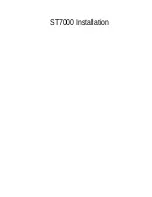
Apart from it taking longer to
fi
nish the analysis, the
only issue is humidity which will have more time to
build up to unacceptable levels.
A solution is to run the pump for short periods
during the analysis, so circulating dry air through the
RAD7 and bringing down the humidity
(
[Setup]
→
[Pump]
→
[On]
[Enter]
and
[Setup]
→
[Pump]
→
[Off]
[Enter]
). A problem
with this, though, is that it aerates the sample and
delivers more water molecules to the desiccant, so
depleting it.
To be able to circulate sample air through the
desiccant and through the RAD7 without aerating the
water sample any further, connect the included RAD
H
2
O Bypass Assembly as shown in Figure 8 in the
previous section.
Th
is will allow the the air
fl
ow to
bypass the aerator as needed.
Th
e Bypass Valve must
be turned o
ff
during the
fi
rst
fi
ve minutes while the
water sample is being aerated. It may be opened for
later circulation of the air round the loop, to keep the
RAD7 dry.
It would be possible to use an entirely di
ff
erent
protocol from WAT-40 or 250. In that case with, say,
SNIFF protocol and 10-minute cycle times, the pump
will run for
fi
ve minutes at the beginning of every
cycle. A
ft
er the
fi
rst cycle the by-pass valve may be
opened to prevent further aeration of the sample.
To determine the original radon concentration in the
water sample a
ft
er a SNIFF protocol reading it will be
necessary to multiply the radon in air measurement
by a factor whose value may be found from a
measurement with WAT 40 or 250 protocol. In fact
the two could be made with the same sample. First
make a normal RAD H
2
O measurement then,
without changing the physical setup, change the
preset WAT protocol to SNIFF, bypass the aerator (to
conserve desiccant) and start a new run.
Th
e readings
will now be radon in air and may be compared
directly with the previous WAT readings of radon in
the water.
7.5 Active DRYSTIK (ADS-2, ADS-3)
If an active DRYSTIK is used instead of a passive
device, the RAD7 pump must be switched O
ff
and
the DRYSTIK pump used instead.
Th
e Active
DRYSTIK models ADS-2 and ADS-3 o
ff
er multiple
air
fl
ow ports.
Th
e High Air
fl
ow port provides an air
fl
ow rate of approximately 1.5 L/min, and it will cause
the aeration to proceed more rapidly than is possible
with the RAD7 pump. But if the DRYSTIK’s Low
Air
fl
ow output is used, the air
fl
ow rate will be much
lower than the RAD7 pump speed; slightly under 0.2
L/min. It will therefore take at least 20 minutes
(instead of
fi
ve) to aerate the sample. In this case it is
recommended that a
ft
er setting the RAD7 to WAT-40
or 250 Protocol, and turning the RAD7 pump O
ff
(
[Setup]
→
[Pump]
→
[Off]
[Enter]
), the cycle
time should be extended to 10 minutes. It will take an
hour to complete the analysis, but virtually no
desiccant will be used if the RAD7 was initially dried
out properly.
7.6 Large Water Samples
Properly aerating w
ater samples larger than 250mL
requires separate hardware, speci
fi
cally the Big Bottle
System, and this involves a more complex procedure.
Th
e Big Bottle System facilitates the measurement of
water samples as large as 2.5 liters. Please see the
Durridge website [www.durridge.com] for details.
Section 7
Deviant Setups
28





































